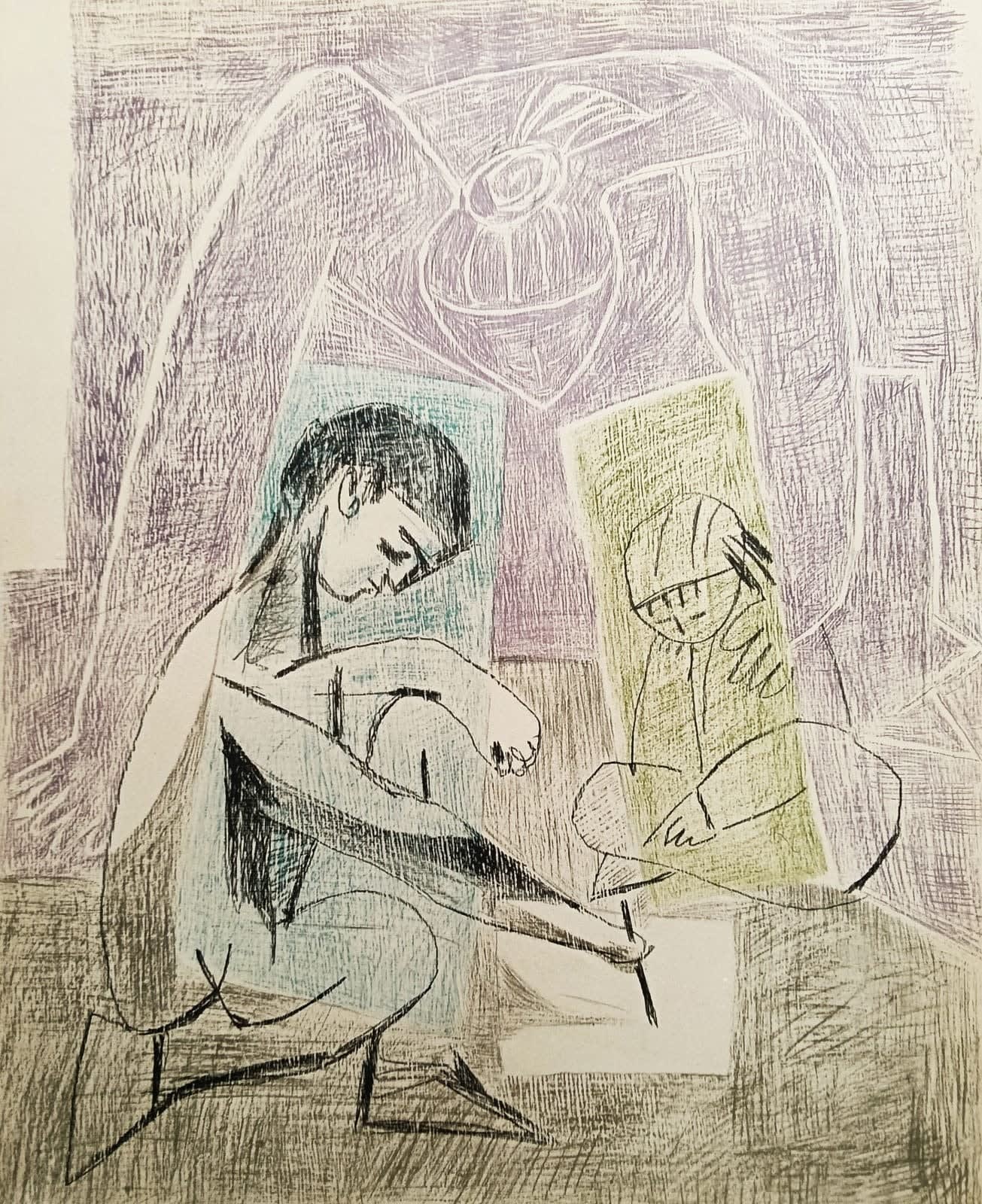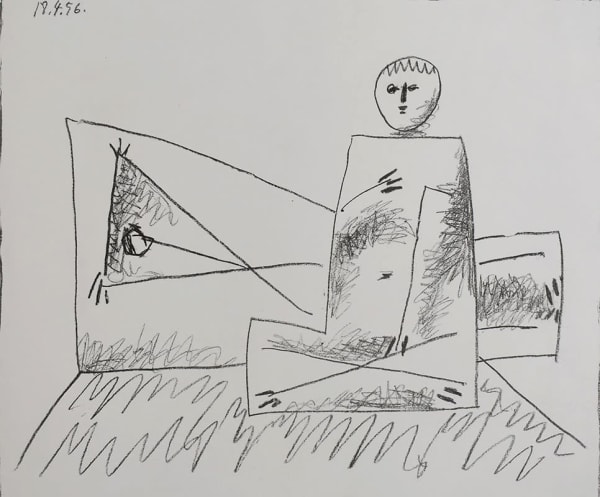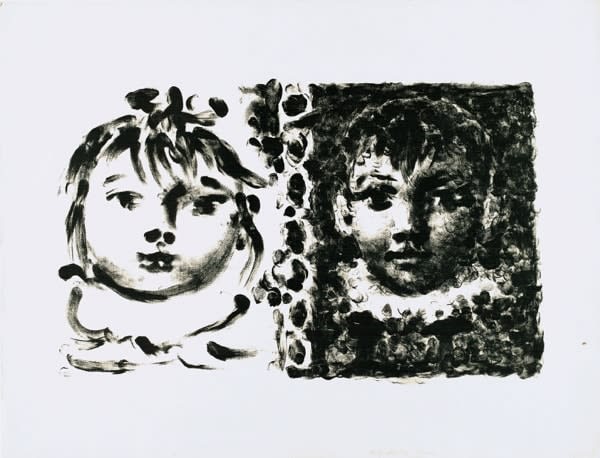-
Artworks

Pablo Picasso
The Little Artist (Draughtsman) | Le petit dessinateur, 1954Original Hand Signed and Numbered Lithograph on Arches Wove Paper26 x 19.7 in
66 x 50 cmEdition of 50.Series: LithographCopyright The ArtistCreated in 1954, Le petit dessinateur (The Little Artist) is a striking example of Pablo Picasso’s extraordinary versatility and technical mastery in printmaking. Executed in the lithographic medium, the work...Created in 1954, Le petit dessinateur (The Little Artist) is a striking example of Pablo Picasso’s extraordinary versatility and technical mastery in printmaking. Executed in the lithographic medium, the work captures an intimate and deeply human moment — a young artist, seated on the ground, absorbed in the act of drawing. It is a composition that bridges simplicity and complexity, showing both Picasso’s gift for distilling form into essential lines and his command over layered textures and tonal variations.
The central figure — the “little artist” — is depicted with an elegance that balances anatomical precision and abstraction. The boy’s posture is natural yet stylized: legs folded, torso bent forward, arm extended with a brush or pencil in hand. The head tilts down in quiet concentration, the weight of his focus palpable. Picasso’s confident, fluid line traces the contours of the figure with minimal yet deliberate strokes, evoking both volume and tenderness. This economy of mark-making reflects the artist’s belief that the most profound expression often emerges from restraint.
Behind the young draughtsman, two framed or window-like forms appear, each containing stylized portraits — one rendered with a soft blue wash, the other in yellow-green. These could be interpreted as the child’s own creations, a glimpse into the imaginative world that exists within his practice. The juxtaposition of the realistically modelled boy with these simplified, almost schematic portraits adds a playful dialogue between artistic representation and abstraction, a theme Picasso often explored.
The background is dominated by a monumental figure drawn in fine, hatched lines and pale lilac tones, looming over the scene like a guardian spirit or muse. The ethereal quality of this presence suggests it might be an embodiment of inspiration itself — a visual metaphor for the forces that watch over and guide the act of creation. This layering of figures — corporeal and spectral — demonstrates Picasso’s mastery of compositional depth, even within a two-dimensional space.
Technically, Le petit dessinateur is a testament to Picasso’s remarkable printmaking skill. By 1954, Picasso had already been working extensively in various graphic media — etching, aquatint, drypoint, linocut, and lithography — and had developed a virtuosity that allowed him to experiment freely while retaining full control over his materials. In lithography, an artist works by drawing onto a stone or metal plate with greasy crayons or inks; this matrix is then treated chemically so that the drawn areas attract ink and the blank areas repel it. The process allows for a remarkable range of tones, from dense blacks to delicate, transparent washes.
Here, Picasso uses the medium’s capacity for tonal layering to great effect. The subtle interplay between the fine hatched textures, the transparent blocks of pastel color, and the confident black contour lines gives the work a dynamic yet balanced rhythm. His handling of space — flattening certain planes while giving others dimensional weight — speaks to his deep understanding of how lithography can merge drawing and painting sensibilities.
The work also reflects Picasso’s lifelong fascination with the act of art-making itself. Across his career, he repeatedly depicted painters, sculptors, and draughtsmen — often as surrogates for himself — engaged in their craft. In The Little Artis*, the subject is not an established master but a child, perhaps recalling Picasso’s own prodigious youth, when his father recognized his extraordinary talent. By portraying a young figure immersed in creation, Picasso nods to the purity and intensity of the artistic impulse, unclouded by academic convention or market demands.
This piece belongs to a period in the early to mid-1950s when Picasso was living in the south of France and working prolifically across painting, ceramics, and printmaking. His collaborations with master printers such as Fernand Mourlot in Paris had opened new technical possibilities, enabling him to push the lithographic process beyond traditional limits. Works from this period reveal his playful yet rigorous approach — blending spontaneous, gestural marks with calculated compositional structures.
In Le petit dessinateur, this synthesis of spontaneity and precision is fully realized. The drawn line is at once swift and exact; the color fields are soft yet purposeful; the interplay between figuration and abstraction invites multiple readings. It is a quiet work, without the overt drama of some of his more famous political or mythological scenes, yet it resonates with the intimacy of observation and the universality of artistic creation.
Ultimately, The Little Artist stands as a celebration of creativity itself — a moment suspended between thought and execution, rendered with the authority of an artist who understood that mastery lies not only in technical skill but also in the ability to convey human truth through the simplest of means. It is a work that underscores Picasso’s unparalleled command over printmaking and his enduring fascination with the act of making art.
For more information on Le petit dessinateur by Pablo Picasso for sale, contact our galleries using the form below.
%3Cdiv%20class%3D%22artist%22%3EPablo%20Picasso%3C/div%3E%3Cdiv%20class%3D%22title_and_year%22%3E%3Cspan%20class%3D%22title_and_year_title%22%3EThe%20Little%20Artist%20%28Draughtsman%29%20%7C%20Le%20petit%20dessinateur%3C/span%3E%2C%20%3Cspan%20class%3D%22title_and_year_year%22%3E1954%3C/span%3E%3C/div%3E%3Cdiv%20class%3D%22medium%22%3EOriginal%20Hand%20Signed%20and%20Numbered%20Lithograph%20on%20Arches%20Wove%20Paper%3C/div%3E%3Cdiv%20class%3D%22dimensions%22%3E26%20x%2019.7%20in%3Cbr/%3E%0A66%20x%2050%20cm%3C/div%3E%3Cdiv%20class%3D%22edition_details%22%3EEdition%20of%2050.%3C/div%3E%3Cdiv%20class%3D%22series%22%3E%3Cspan%20class%3D%22artwork_caption_prefix%22%3ESeries%3A%3C/span%3E%20Lithograph%3C/div%3ERelated artworks-
 Pablo PicassoLe Corsage à Carreaux, 1949
Pablo PicassoLe Corsage à Carreaux, 1949 -
 Pablo PicassoGrand Maternite, 1963
Pablo PicassoGrand Maternite, 1963 -
 Pablo PicassoFrançoise Sur Fond Gris, 1950
Pablo PicassoFrançoise Sur Fond Gris, 1950 -
 Pablo PicassoReclining Man and Crouching Woman | Homme couché et femme accroupie, 1956
Pablo PicassoReclining Man and Crouching Woman | Homme couché et femme accroupie, 1956 -
 Pablo PicassoJacqueline Profile to the Right, 1958
Pablo PicassoJacqueline Profile to the Right, 1958 -
 Pablo PicassoLes Demoiselles d'Avignon, 1953
Pablo PicassoLes Demoiselles d'Avignon, 1953 -
 Pablo PicassoBuste au fond étoilé (Bust with Star Background), 1949
Pablo PicassoBuste au fond étoilé (Bust with Star Background), 1949 -
 Pablo PicassoJeu De La Cape (Bloch 1015), 1961
Pablo PicassoJeu De La Cape (Bloch 1015), 1961 -
 Pablo PicassoTete De Femme Fond Noir, 1946
Pablo PicassoTete De Femme Fond Noir, 1946 -
 Pablo PicassoBuste de Femme au Corsage Blanc (Jacqueline de Profil), 1957
Pablo PicassoBuste de Femme au Corsage Blanc (Jacqueline de Profil), 1957 -
 Pablo PicassoFemme à L'Italienne d'après le tableau de Victor Orsel (Bloch 740), 1953
Pablo PicassoFemme à L'Italienne d'après le tableau de Victor Orsel (Bloch 740), 1953 -
 Pablo PicassoGrand Nature Mort au Compotier, 1947
Pablo PicassoGrand Nature Mort au Compotier, 1947 -
 Pablo PicassoAfter The Embrace, 1901
Pablo PicassoAfter The Embrace, 1901 -
 Pablo PicassoProfil de Femme
Pablo PicassoProfil de Femme -
 Pablo PicassoProfil au fond noir, 1947
Pablo PicassoProfil au fond noir, 1947 -
 Pablo PicassoRonde de la Jeunesse, 1961
Pablo PicassoRonde de la Jeunesse, 1961 -
 Pablo PicassoFemme à la Robe
Pablo PicassoFemme à la Robe -
 Pablo PicassoJacqueline with Roses, 1956
Pablo PicassoJacqueline with Roses, 1956 -
 Pablo PicassoPaloma et Claude, 1950
Pablo PicassoPaloma et Claude, 1950 -
 Pablo PicassoBuste, 1957
Pablo PicassoBuste, 1957 -
 Pablo PicassoPortrait de Femme II, 1955
Pablo PicassoPortrait de Femme II, 1955 -
 Pablo PicassoTête de Jeune Fille – Portrait de Françoise, 1949
Pablo PicassoTête de Jeune Fille – Portrait de Françoise, 1949 -
 Pablo PicassoJeunesse, 1950
Pablo PicassoJeunesse, 1950
-
Join our mailing list
* denotes required fields
We will process the personal data you have supplied in accordance with our privacy policy (available on request). You can unsubscribe or change your preferences at any time by clicking the link in our emails.
This website uses cookies
This site uses cookies to help make it more useful to you. Find out more about cookies.























